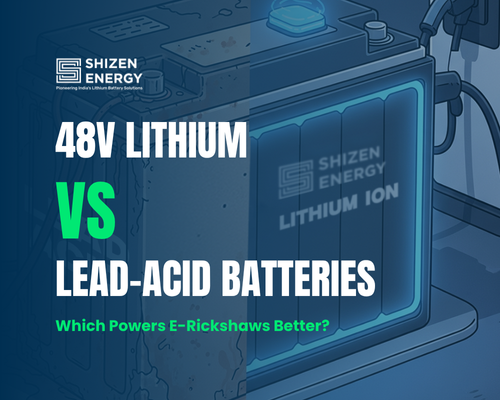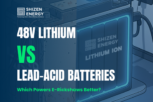
Electric rickshaws (e-rickshaws) are rapidly gaining popularity across India for their numerous benefits over conventional auto-rickshaws. These include cleaner emissions, reduced noise pollution, and lower operating costs. While lead-acid batteries have traditionally been used for this purpose, recent advancements in battery technology have introduced 48V lithium-ion batteries for e-rickshaws. But with two strong options to choose from, as an e-rickshaw owner or fleet operator, you might be confused between lithium vs lead-acid battery e-rickshaw. Which one should you buy for your business, and which one is actually the best battery for e-rickshaw fleets?
This lithium battery for e-rickshaw buyer’s guide by Shizen Energy India will help you make an informed decision by comparing both lithium and lead-acid technologies on various key parameters of performance, cost, ROI, safety, and more.
48V Lithium vs Lead-Acid Batteries: A Quick Overview
48V Lithium-Ion Batteries
Advanced technology with higher energy density, longer life, and better performance but at a higher initial investment.
Lead-Acid Batteries
Traditional e-rickshaw workhorse with lower upfront costs but higher weight, maintenance, and environmental issues.

E-Rickshaw Battery Comparison Table
While this comparison highlights the 48V standard, the same advantages of lithium over lead-acid apply across other voltage ranges as well, depending on vehicle configuration.
| Feature | 48V Lithium Battery for E-Rickshaw | Lead-Acid Battery |
|---|---|---|
| Voltage | 48V (standard for e-rickshaws) | 48V (standard) |
| Lifespan (cycles) | 2000–3000+ | 300–500 |
| Weight | 25–35 kg | 60–80 kg |
| Charging Time | 2–4 hours | 8–10 hours |
| Maintenance | Minimal | Frequent (water top-up, cleaning) |
| Upfront Cost | Higher | Lower |
| Total Cost of Ownership (TCO) | Lower over time | Higher (due to replacements) |
| Environmental Impact | Low (recyclable, non-toxic) | High (toxic, hard to recycle) |
| Range per Charge | 80–120 km | 50–70 km |
Which is Better for E- Rickshaws:
Performance & Efficiency
Lithium-ion batteries maintain consistent voltage and power output throughout the discharge cycle, ensuring your e-rickshaw doesn’t slow down as the battery gets drained. Lead-acid batteries, on the other hand, suffer from voltage drop-off, leading to a sluggish ride and reduced range over time.
Long-lasting e-rickshaw battery: Lithium batteries last 4–6 years on average, while lead-acid batteries need to be replaced every 1–1.5 years.
Electric rickshaw battery range: A 48V lithium battery for e-rickshaw provides 80–120 km per charge, significantly higher than lead-acid batteries. This means drivers can cover more distance without worrying about mid-day charging, ultimately leading to more money earned per day.
Charging & Maintenance
Charging Time:
Lead-acid batteries take 8–10 hours to charge fully, while lithium batteries can be charged in 2–4 hours. This means that if you switch to lithium, your e-rickshaws will be on the road for longer and generating more revenue.
Maintenance:
Lithium batteries are virtually maintenance-free, while lead-acid batteries require regular water top-ups, cleaning of terminals, and checking for acid leaks. This saves a lot of time and hassle in the long run.
Cost & ROI
Upfront vs. Long-Term Costs:
Lead-acid batteries have lower initial costs but need to be replaced more frequently, typically every 12–18 months. Over a 5-year period, you could end up replacing a lead-acid battery 3–4 times, while a lithium battery would last the entire duration.
Total Cost of Ownership (TCO):
When you factor in maintenance, energy efficiency, and replacement costs, lithium batteries have a much lower TCO.
Electric rickshaw battery upgrade:
Upgrading from lead-acid to lithium may require a higher initial investment, but the ROI comes in the form of fuel savings, reduced breakdowns, and more operating hours.
Safety & Sustainability
Safety:
Li-ion battery benefits also include better safety features, thanks to modern Battery Management Systems (BMS) that prevent overcharging, overheating, and short circuits. Lead-acid batteries are more prone to leaks, acid spills, and even explosions if mishandled.
Sustainability:
Li-ion batteries are more environmentally friendly, with recyclable components and no toxic lead or acid. Lead-acid batteries, on the other hand, have significant disposal and recycling challenges, posing environmental hazards.
Real-World Pros & Cons
Lead-Acid Battery Pros:
- Lower initial cost
- Easy availability
Lead-Acid Battery Cons:
- Heavy and bulky, reducing overall vehicle efficiency
- Frequent battery replacement with lead-acid batteries
- High maintenance and risk of acid spills
- Shorter range and longer charging time
- Environmental hazards and disposal issues
48V Lithium Battery Pros:
- Lightweight, improves vehicle performance
- Long-lasting e-rickshaw battery (4–6 years)
- Fast charging and minimal maintenance
- Higher range per charge
- Safer and more sustainable
48V Lithium Battery Cons:
- Higher upfront investment
- Requires compatible charger and BMS
Who Should Choose Which?
Daily, high-mileage drivers and fleet operators: If your priority is uptime, reliability, and long-term savings, lithium is the clear winner. If you are using your e-rickshaw for low-mileage, occasional use, or short-distance trips, and have budget constraints, you might consider lead-acid.
Budget-constrained, low-usage owners: If you can’t afford the initial investment for lithium and only care about short-term costs, lead-acid may be an option. However, you will have to factor in the higher maintenance, more frequent replacements, and shorter vehicle life.
Frequently Asked Questions
Yes, most e-rickshaws can be retrofitted with a 48V lithium battery for e-rickshaw use. However, you must ensure compatibility with your vehicle’s controller and charger. We at Shizen Energy India can help with an electric rickshaw battery upgrade consultation to ensure a seamless lithium battery for e-rickshaw.
A high-quality 48V lithium battery can provide you with 80–120 km per charge, depending on the load, driving conditions, and battery capacity.
Lithium batteries can be fully charged in 2–4 hours, while lead-acid batteries require 8–10 hours for a complete charge.
Final Recommendation: Lithium or Lead-Acid Battery for E-Rickshaw?
For most e-rickshaw owners, fleet operators, and dealerships looking for the best battery for e-rickshaw, 48V lithium batteries are the obvious choice. They offer better performance, longer life, lower maintenance, and higher ROI when compared to traditional lead-acid batteries.
The only downside is the higher upfront cost, but the long-term savings on fuel, repairs, and vehicle downtime will easily offset this. As a lithium battery for e-rickshaw manufacturer, we at Shizen Energy India are confident that you will be impressed with our innovative, reliable, and sustainable battery solutions for e-rickshaws.
So what are you waiting for? Contact us today to power your e-rickshaw fleet with the latest in battery technology and start saving money while generating more revenue.
About Shizen Energy India
Shizen Energy India is a leading manufacturer of high-performance lithium battery packs for e-rickshaws, energy storage systems, and material handling equipment. Since its inception in 2019, we have been at the forefront of lithium-ion battery solutions, providing quality, reliable, and innovative power sources to power a greener future for India’s mobility and energy needs.
If you have any queries or would like a product demo, please reach out to our team at Shizen Energy India, your partner in next-generation energy solutions.




